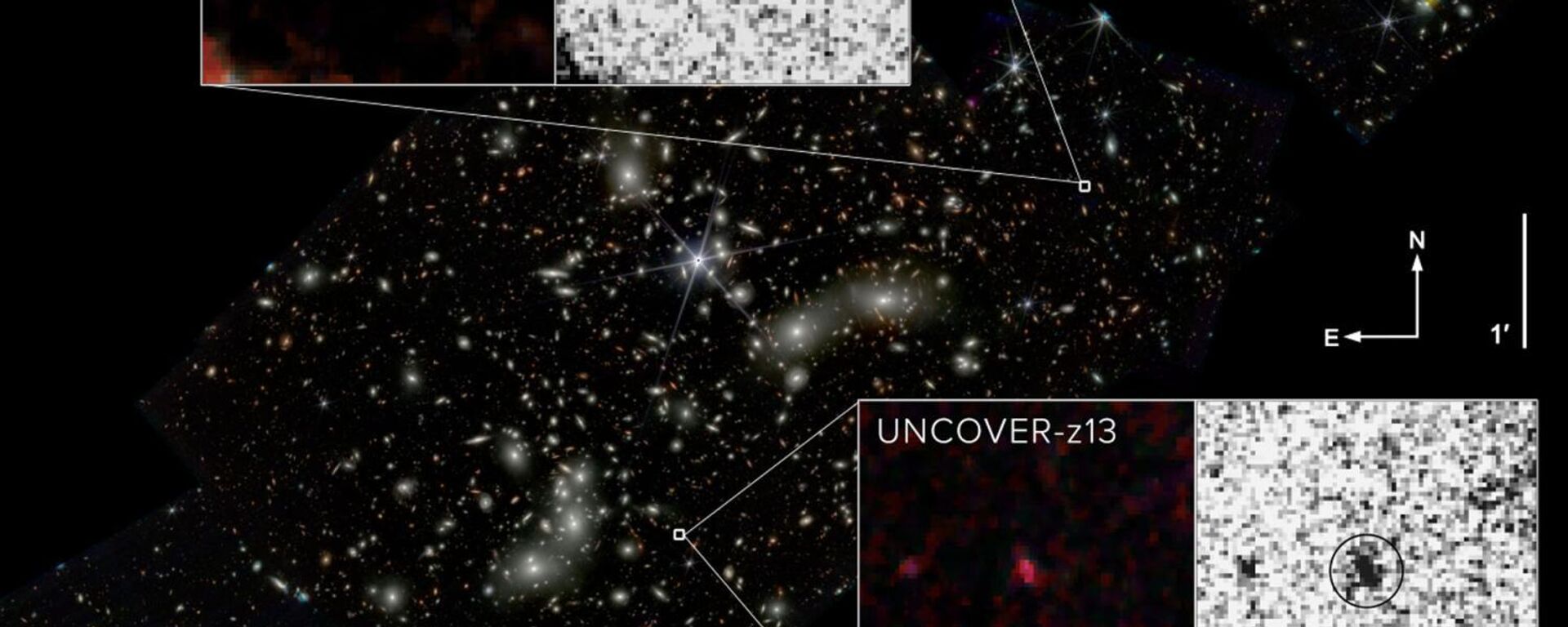https://sputnikglobe.com/20231121/webb-telescope-reveals-cosmic-chain-of-20-galaxies-in-early-universe-1115117547.html
Webb Telescope Reveals Cosmic Chain of 20 Galaxies in Early Universe
Webb Telescope Reveals Cosmic Chain of 20 Galaxies in Early Universe
Sputnik International
The James Webb Space Telescope (JWST) has unveiled a colossal "Cosmic Vine" — a sprawling chain of at least 20 closely connected galaxies in the early universe.
2023-11-21T22:20+0000
2023-11-21T22:20+0000
2023-11-21T22:19+0000
beyond politics
science & tech
james webb space telescope (jwst)
space
space exploration
galaxy clusters
https://cdn1.img.sputnikglobe.com/img/07e7/0b/15/1115117215_0:19:1183:684_1920x0_80_0_0_23ac32a1d5741e5a8200890f2c4bda6c.png
Scientists recently revealed the discovery of a chain of at least 20 closely packed galaxies, a find that officials believe will provide an improved understanding of the formation of large structures in space.Astronomers made the remarkable find while utilizing data from the Webb telescope and studying the Extended Groth Strip, which is situated between the constellations Ursa Major and Boötes. The 'Cosmic Vine,' as the discovery has been dubbed in a study, spans an astonishing 650,000 light-years in width, significantly surpassing other galaxy groups observed in the early universe.The massive structure exhibited a redshift of approximately 3.44, indicating light emitted around 11 to 12 billion years ago. Researchers believe the structure is in the process of becoming a galaxy cluster, the most massive body in the universe bound by gravity.One hypothesis is that recent galactic mergers triggered wild bursts of star formation, depleting available gas half a billion years before the Webb telescope's observations. The discovery adds to the list of perplexing structures in the early universe, challenging astronomers to unravel the mysteries concealed within this ancient galactic chain.The study is available at the the preprint database arXiv.As scientists delve deeper into the implications of the Cosmic Vine, the Webb telescope continues to be an invaluable tool, raising more questions about the nature of our universe than it answers.
https://sputnikglobe.com/20231114/webb-space-telescope-uncovers-two-most-distant-galaxies-yet-1114961596.html
Sputnik International
feedback@sputniknews.com
+74956456601
MIA „Rossiya Segodnya“
2023
News
en_EN
Sputnik International
feedback@sputniknews.com
+74956456601
MIA „Rossiya Segodnya“
Sputnik International
feedback@sputniknews.com
+74956456601
MIA „Rossiya Segodnya“
james webb telescope, cosmic vine, what is cosmic vine, where is cosmic vine, famous galaxies, galaxy cluster
james webb telescope, cosmic vine, what is cosmic vine, where is cosmic vine, famous galaxies, galaxy cluster
Webb Telescope Reveals Cosmic Chain of 20 Galaxies in Early Universe
The celestial structure, stretching over 13 million light-years in a bow shape, has astronomers intrigued about the formation of the largest structures in the cosmos.
Scientists recently revealed the discovery of a chain of at least 20 closely packed galaxies, a find that officials believe will provide an improved understanding of the formation of large structures in space.
Astronomers made the remarkable find while utilizing data from the Webb telescope and studying the Extended Groth Strip, which is situated between the constellations Ursa Major and Boötes. The 'Cosmic Vine,' as the discovery has been dubbed in a study, spans an astonishing 650,000 light-years in width, significantly surpassing other galaxy groups observed in the early universe.
With an estimated mass of 260 billion solar masses, the 'Cosmic Vine' is still growing, though its two largest galaxies are showing signs of halting star formation.
These "quiescent" galaxies, a rarity in the ancient universe, have prompted researchers to weigh the factors behind such early cosmic stagnation.
The massive structure exhibited a redshift of approximately 3.44, indicating light emitted around 11 to 12 billion years ago. Researchers believe the structure is in the process of becoming a galaxy cluster, the most massive body in the universe bound by gravity.
One hypothesis is that recent galactic mergers triggered wild bursts of star formation, depleting available gas half a billion years before the Webb telescope's observations. The discovery adds to the list of perplexing structures in the early universe, challenging astronomers to unravel the mysteries concealed within this ancient galactic chain.

14 November 2023, 22:18 GMT
The study is available at the the preprint database
arXiv.
As scientists delve deeper into the implications of the Cosmic Vine, the Webb telescope continues to be an invaluable tool, raising more questions about the nature of our universe than it answers.



